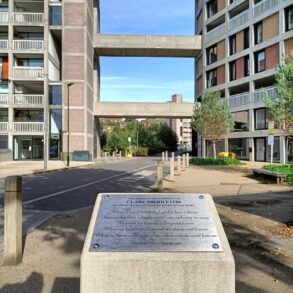Melbourne is internationally renowned for its street art, particularly the colourful and complex murals of the city’s laneways.
But one graffiti symbol has reached new levels of notoriety, both through sheer force of numbers and for appearing in prominent – often hard-to-access – places.
A long Pam the bird at the Wurundjeri Way and Lorimer Street intersection, near the DFO South Wharf.Credit: Joe Armao
The tag is known as “Pam the bird” and once you see it, you’ll keep spotting it all over the place. For the past few years, this simple outline illustration of a bird has been popping up across the city, particularly in the western suburbs.
It’s on the back of road signs and alongside railway lines, with sightings often documented on social media. The style can differ: sometimes Pam is long and thin, other times short and stout.
The tag has developed an online cult following, inspiring T-shirt merchandise.
Pam the bird on the Flinders Street Station clock tower. Credit: Victoria Police
But Pam has also caused controversy this year, appearing on heritage sites, including the Flinders Street Station clock and the Uncle Toby’s factory in West Footscray. Both pieces involved audacious climbing, prompting questions about how the perpetrators were able to get to such out-of-reach locations.
The person or people behind Pam the bird are cloaked in mystery, as is commonly the style of those in the graffiti world.
To try to get some answers, The Age contacted an Instagram account, @goodbirdart. While claiming to be “managed by a third party”, the page regularly posts behind-the-scenes images and videos of Pam graffiti.
A photo from @goodbirdart, an Instagram account that regularly posts behind-the-scenes images and videos of Pam.Credit: Instagram/goodbirdart
The Age was unable to verify if the account is legitimately connected to the Pam tag, and many of the answers provided to our questions appeared to be tongue-in-cheek.
In response to our direct messages, @goodbirdart said Pam was a shoebill bird and the tag was inspired by a primary school picture drawn in grade three. The teacher’s name was Pam, according to the account.
The account said it had “hundreds of run-ins with the police”. “Thank f— they can’t fly. Makes it really easy to escape,” they said.
Pam is a tag of the “MP” graffiti crew, a group of connected artists – or vandals, depending on your view. Those letters often appear underneath the bird.
However, when asked how many people were involved, @goodbirdart said: “The birds aren’t painted by people… they are painted by birds.”
After a follow-up question, the account responded: “That information is not shared with the general public.” As for preferred Pam locations, the page said: “Wherever all the cool trendy birds like to hang out.”
In response to a question about climbing equipment used for Pam tags in high and hard-to-reach places, @goodbirdart said: “Abseiling? Pffft having wings is where it’s at.”
While the number of Pams that have appeared across Melbourne is probably in the hundreds, if not thousands, the account didn’t offer an estimate. “Who gives a shit,” they said.
The Uncle Toby’s factory in West Footscray. Credit: Joe Armao
As for why it has such a cult following? “Because it’s a very good drawing of a bird,” the account said.
Authorities have not had much success in stemming the Pam tide.
Late last year, police charged a man over allegedly tagging Pam inside the City Loop, according to the Herald Sun.
Road signs are a popular location for Pam the bird.Credit: Joe Armao
When asked about this, @goodbirdart downplayed any connection with the man: “From the information provided, Victoria Police have yet to convict him of any Pam bird-related offences.”
Sergeant Duncan Browne, of the transit divisional response Unit, which investigates property crime on the public transport network, said police were keeping a close eye on graffiti crews, such as those responsible for Pam the bird.
The unit has specialist analysts who identify graffiti offenders, tags and trends. That included monitoring social media, Browne said, as it was often used to claim notoriety.
“Graffiti is an unusual criminal subculture in that it doesn’t run on money, unlike drug-dealing or other parts of the underworld,” he said.
“Notoriety and fame is their currency. So in that sense, you have to be bigger, more out there than the last person that pushes the boundaries. That creates danger on the network.”
Browne said Pam the bird was unusual among graffiti tags in that it had an online “brand” that had cut-through with the public.
“Therefore, people see it and they recognise it,” he said. “What people don’t often realise is that there’s other volume graffiti vandals who are equally big or as prolific in Melbourne, but you don’t see that.”
The former Bradmill site in Yarraville.Credit: Joe Armao
Since January, 840 incidents of graffiti or criminal damage on public transport have been reported to police. Police have charged 82 people with graffiti-related offences.
The consequences for being caught can be serious.
This year, James Scott-Howarth admitted to 14 counts of criminal damage and theft during his time with the 70K crew, whose tags in public places became notorious in the CBD between 2001 and 2005.
It took police 20 years to charge Scott-Howarth, who had left the country for Britain after a raid on his house and parents’ business. He was sentenced to a two-year community corrections order and 300 hours of community work.
Credit: Matt Golding
University of Melbourne academic Chris Parkinson, who teaches art theory, including graffiti, said Pam the bird skirts the edges of approved street art and criminalised vandalism.
He said the Flinders Street Station example showed that the artists were incorporating a “sense of play” that responded to the architecture of the building.
“Those kinds of designations really render it as street art,” he said.
“Because it’s site-specific. It relies upon the street as a canvas for it, and it’s playful, but also there’s this element of legibility – it’s a bird, everyone gets it.
The bird comes in several styles.Credit: Joe Armao
“I think the mystery, too, is a really important part of it culturally – the sense of anonymity and being able to build up this myth.”
And @goodbirdart’s response to that debate and those who call them vandals? “Well it is vandalism, so they aren’t wrong.”
This post was originally published on this site be sure to check out more of their content.








